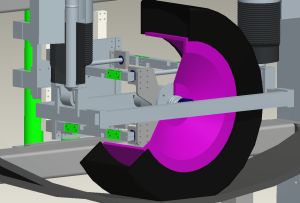Tomorrow’s vehicle is light and safe, produces hardly any noise, it is emission-neutral, energy-efficient, and affordable. It can be operated easily and rapidly finds its way to the destination. Researchers at the Chair of Vehicle Technology of Karlsruhe Institute of Technology (KIT) work on making this vision come true. One focus lies on the reduction of noise. For this purpose, the scientists are developing a model for the fast calculation of the vibrations of a rolling tire.
Development of new vehicles is becoming more and more complex due to a large number of electronic, electric, and mechatronic components. “This development process must be designed efficiently to reduce time and costs,” explains Professor Frank Gauterin, Head of the KIT Institute of Vehicle System Technology (FAST) and scientific spokesman of the KIT Mobility Systems Center. “In addition, the properties of the vehicles have to be optimized in terms of energy efficiency, driving safety, and user friendliness.” At the Chair of Vehicle Technology headed by Gauterin, the scientists analyze passenger cars and commercial vehicles as systems in interaction with their environment and with the driver.
The researchers develop operation strategies for energy-efficient driving, which constantly consider current data on the state of operation of the car, routing and type of the roads, and on other vehicles. They study the benefits and acceptance of driver assistance systems and perform studies to find out how drivers can be supported optimally by various optical, acoustic, and haptic signals. Studies on the user behavior among others deal with the practice of electromobility. Driving safety is addressed by several studies focusing on the driving behavior, with particular attention being paid to the tire, road, chassis, and complete vehicle.
A series of projects executed by the Chair of Vehicle Technology covers noticeable and audible vibrations during driving, an issue that is of relevance to both driving comfort and environmental protection. Tires play an important role in noise development. “The noise produced by rolling tires is clearly audible at speeds ranging between 40 and 150 km per hour. The rougher the road, the louder is the noise,” explains Frank Gauterin.
In cooperation with several automotive manufacturers and a tire manufacturer, the researchers of Gauterin’s team develop a vibration model of the rolling tire in the frequency range responsible for the rolling noise. “Due to its material properties and mechanics, the tire is a very complex component. The challenge is to generate a simulation model of adequate accuracy, which is still able to calculate rapidly,” says Professor Gauterin. The tire model developed by KIT is supposed to do this. It considers the properties of the road and can be used to describe the forces acting in the contact zone between tire and road.
The researchers combine the tire model with a chassis simulation model in order to simulate the transmission of vibration in the system. At a test rig, a chassis, the properties of which can be adjusted variably, they verify their model. In this way, science contributes to simulation in automotive development: “For future new developments, manufacturers can couple the vehicle model with a tire model and generate the complete noise characteristics of the new vehicle on the computer,” explains Frank Gauterin.
The Mobility Systems Center pools KIT activities relating to vehicle technology. Presently, 40 institutes with about 800 employees on KIT Campus North and Campus South are working on methodological and technical fundamentals for tomorrow’s vehicles. It is their objective to develop energy-efficient, low-emission, and safe vehicles and mobility concepts. Research also covers the complex interactions of vehicle, driver, traffic, and society.
Under the heading of “Future Mobility”, KIT will present its scientific activities on its new “Campus East – Mobility and Innovation” during an Open Day on July 02. More information can be found at: www.pkm.kit.edu/3072.php
In close partnership with society, KIT develops solutions for urgent challenges – from climate change, energy transition and sustainable use of natural resources to artificial intelligence, sovereignty and an aging population. As The University in the Helmholtz Association, KIT unites scientific excellence from insight to application-driven research under one roof – and is thus in a unique position to drive this transformation. As a University of Excellence, KIT offers its more than 10,000 employees and 22,800 students outstanding opportunities to shape a sustainable and resilient future. KIT – Science for Impact.

